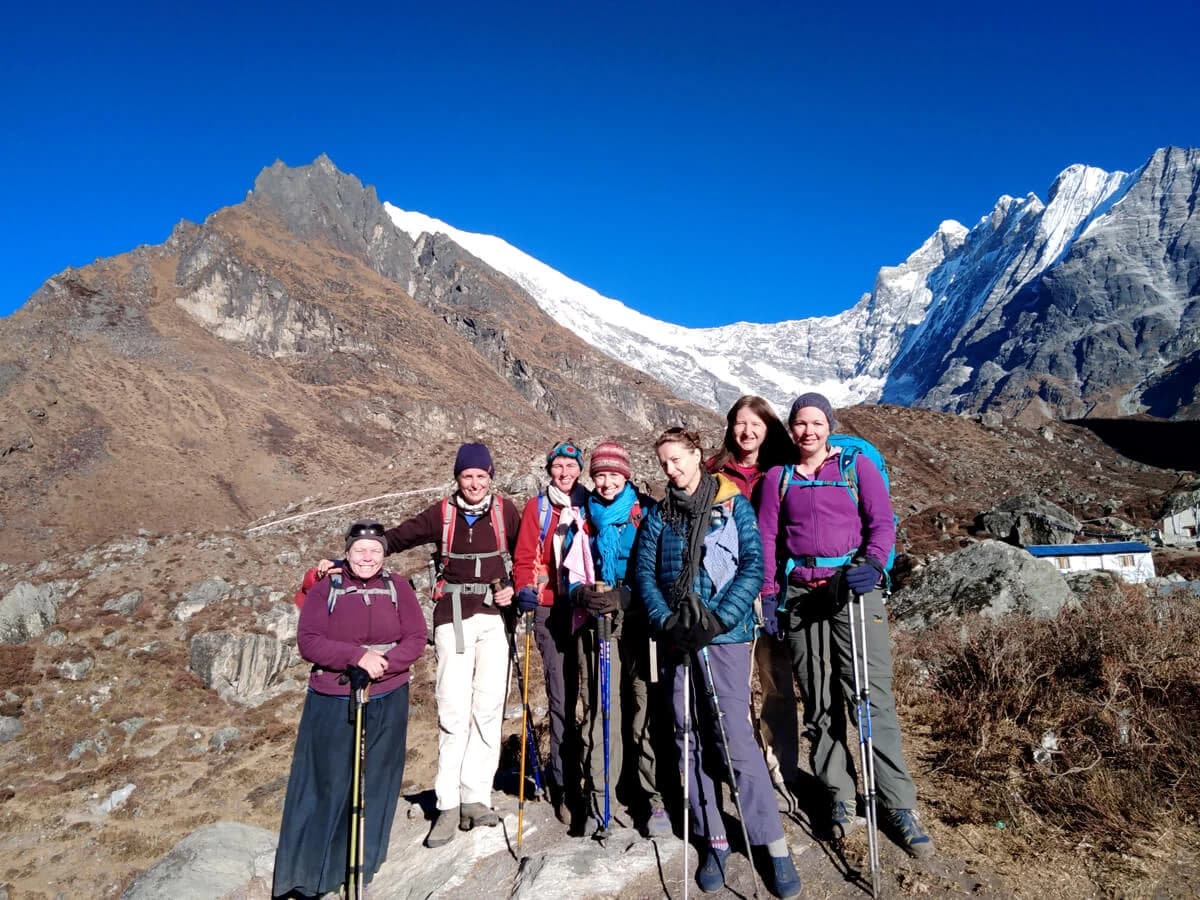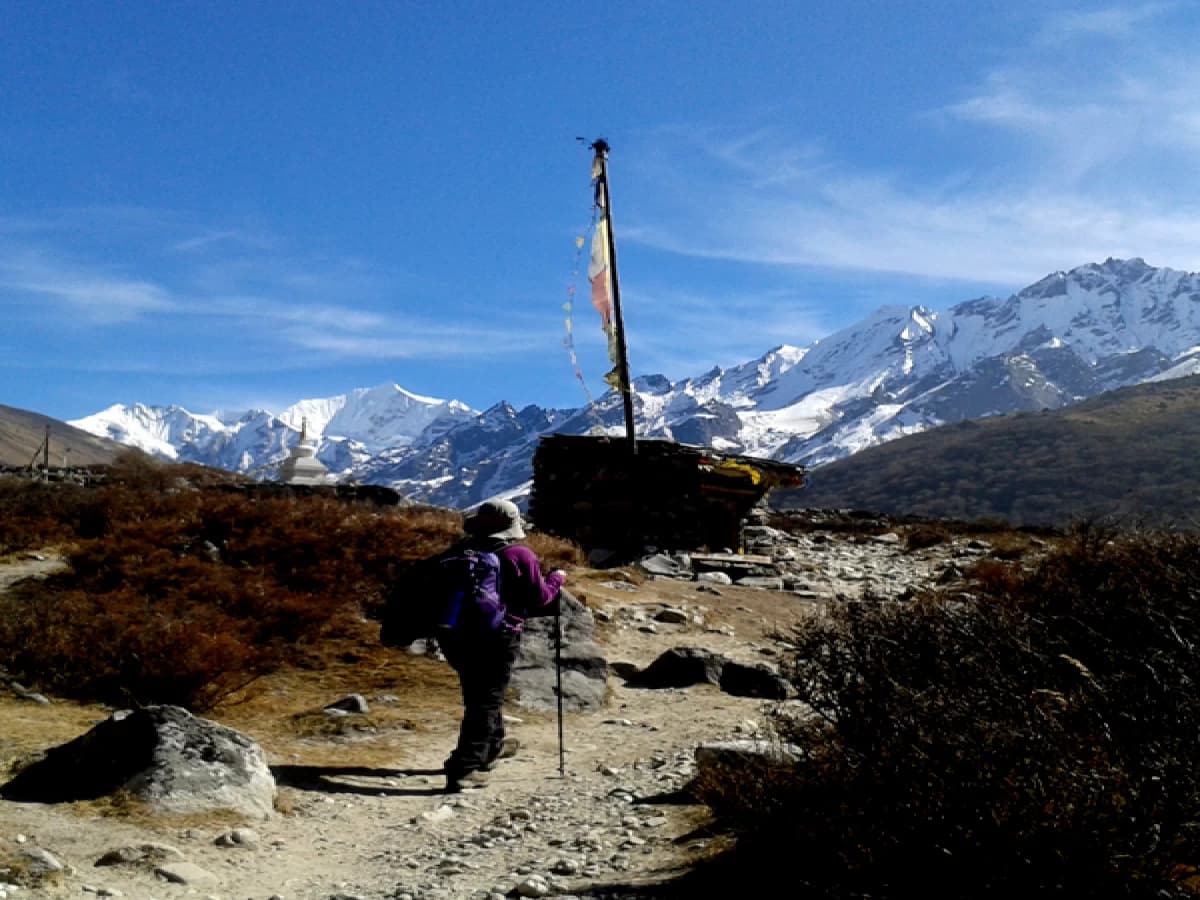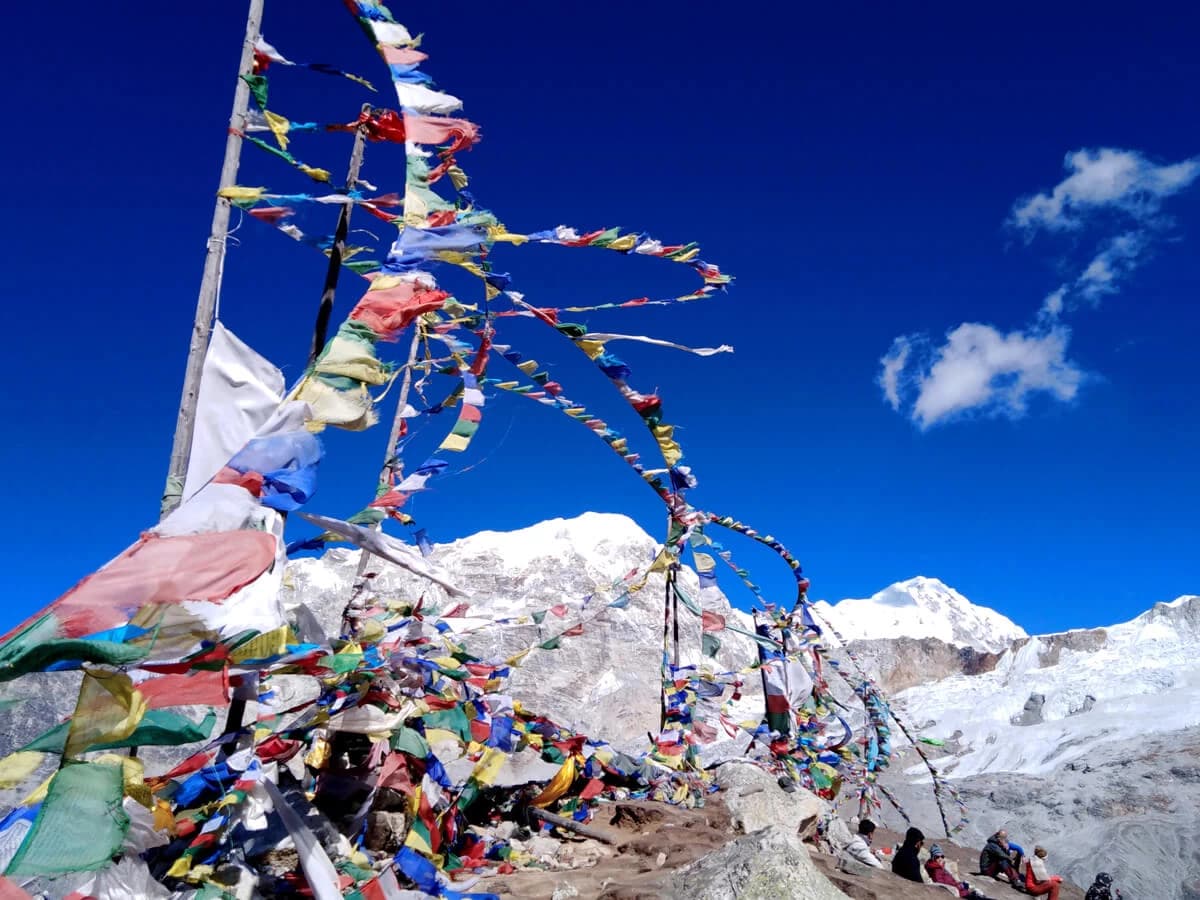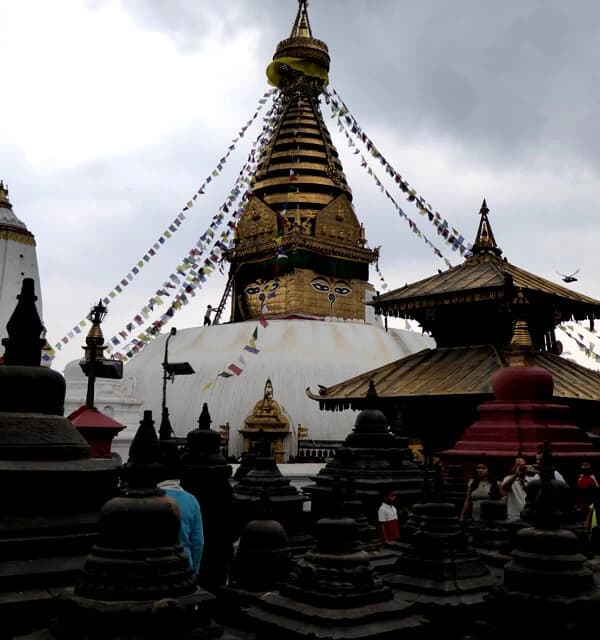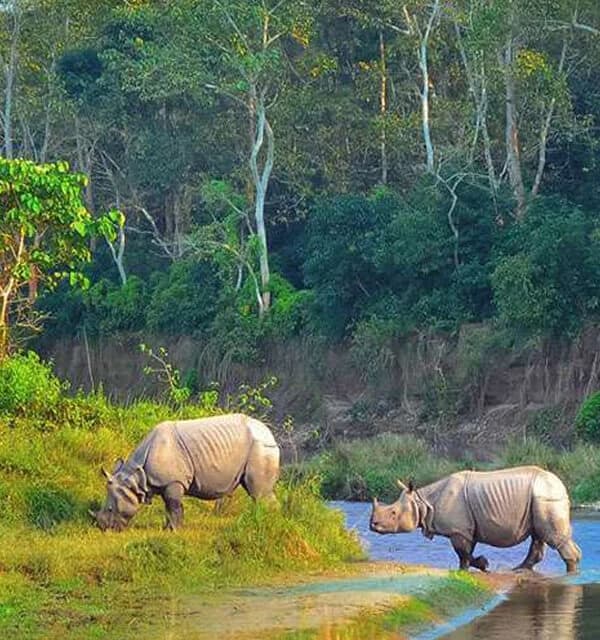Planning to do the Langtang Valley Trek in Nepal! This page provides a detailed day-to-day itinerary for a week, yet experience the best of Langtang Valley’s natural beauty, scenic mountains, and immersive culture.
Trekking Langtang Valley - 8 Days
Trip Overview
Trekking in Langtang Valley, Nepal, is one of the shortest trekking routes near Kathmandu, with a maximum altitude of 4770 meters. Located in the Northern region of Nepal, it lies within the Langtang National Park near Rasuwa district. This trek offers a unique blend of ecosystems at every stage. With every acclimatization, you can notice a significant shift in vegetation from lush green forest to alpine landscapes. It is home to rare and beautiful wildlife such as red pandas, Himalayan tahr, musk deer, langurs, and various species of birds.
Is the Trekking Langtang Valley worth it in 2026?
Nepal offers different trekking options based on the traveler's choices. From rough alpine vegetation to green hills, along with different cultures, traditions, and customs in different communities that have lived for centuries. Not only the way of natives, but also different species of wild animals and bird species that differ along the geography. Langtang Valley is one of the treks that offers a unique blend of cultures and ecosystems. A region that is majorly influenced by the Tibetan-Buddhism culture consists of the Tamang and Sherpa communities, an indigenous tribe of Nepal's Himalayas.
Langtang Valley is popular for being a moderate difficulty trek suitable for all age groups and for those who seek spiritual places with awe-inspiring views of the Himalayas. An ancient monastery carrying the history of Langtang, the Kyanjin Gompa, and prayer wheels leading the path for travelers towards history. Not only is the cultural significance unique, but the vegetation of the Langtang Region is also unique in comparison. The trail mostly starts from the temperate zone and reaches to subalpine/alpine zone of Nepal. Due to such significant changes in vegetation and cultural influences, the Langtang trek offers its visitors a unique opportunity to experience the life of people and of the wild. So, if you are a culturally enthusiastic person, looking for spiritually significant places along with views of the Himalayas, or a naturalist, then this trek is your go-to option. Langtang Valley is one of the short treks that covers every aspect of a journey, from the stunning views of nature to the cultural significance near Kathmandu. So, it is still worth doing in 2025/2026 and maybe even in the coming years.
Can I make Trekking Langtang Valley my story?
If you’re short on time but still dream of experiencing the Langtang Valley Trek, this trek is made for you. It’s ideal for those who are looking for a rewarding journey with moderate fitness and limited time, but with a spirit for adventure.
Langtang Valley is not known only for its astonishing view of the Langtang Range, but the cultural experience you can gain from it is also distinctive. Langtang Valley is a perfect blend of ecosystem and culture. Being a remote yet developed trekking area, this trek offers you an immersive cultural experience of Tibetan Buddhist Customs. Another reason for the popularity of Langtang Valley among trekkers is its beginner-friendly trail leading along the hills and rivers.
If you are a solo traveler on a tight schedule, a beginner trekker, or someone looking for a weeklong holiday, this well-planned trip offers the perfect balance of time, natural beauty, and culture.
Is it possible for beginners to complete the Langtang Trek?
The beauty of the Trekking Langtang Valley is not limited to astonishing views, the valleys, and the diverse culture. But also, the homely presence for every trekker. While doing the Langtang Valley trek, you have multiple options on how to make the plan and end the trek. During the Langtang Valley trek, you can choose between the Kyanjin Ri climb and the Tsergo Ri climb. With an extended itinerary, it is also possible to do both. So, what’s the difference between these two peaks?
Kyanjin Ri lies right above the renowned Kyanjin Gompa, an ancient monastery of those who practiced mixed Tibetan Buddhism. At an altitude of 4770M above sea level, Kyanjin Ri serves as a viewpoint for a panoramic scenery of the mountains. Kyanjin Ri is divided into two viewpoints, one at a lower point and one a bit higher. Both offer an astonishing view of the Langtang, Gangchempo, and Ganja La.
Tsergo Ri is much farther from the Kyanjin Gompa, located near Yala Peak(5500M). In comparison, Tsergo Ri can be harder, since the altitude reached is above 5000M above sea level. The view from Tsergo Ri is better and clearer than from Kyanjin Ri, as the altitude of the peak is higher and closer to other neighboring peaks.
So, from these explanations, you can choose how you want your trek. If you are a beginner and do not want a challenge, you can do the Kyanjin Ri. If you are a professional and like to do more challenging treks, then Tsergo Ri can be your option, which makes the Langtang Trek suitable for every trekker of all age groups.
Best time to do the Langtang Valley Trek!
Doing trek at the right time is not limited to suitable weather. Traveling doesn’t only include reaching the destination and taking photos of the Himalayas, but also carrying sweet memories of the journey, cultural and traditional experiences, and the trip as a whole.
If one were to say in short, the best time to do treks would be the peak season of trekking, which has been in practice since the time of travelling, and that would be specific months starting from September to December and late March to early June. Why these specific months? From September to December, it’s the time of autumn/winter in the early stage, and the weather is appropriate for travelling. Coincidentally, the major festivals of Nepal (Dashain and Tihar) fall around the same time, allowing you to experience century-old traditions. Let’s break down the different experiences of the trekking season in Nepal:
March – May: Pre-monsoon (Spring season)
- Light and warm days make trekking easy during the day.
- Mostly clear weather offers a panoramic view of Langtang and other mountains.
- Different alpine flowers make the trail colorful.
- Trails are mostly dry and safe.
- Villages prepare for spring festivals, adding local charm.
September – December: Post-monsoon (Autumn season)
- The rains have cleared the dust and haze, offering the best visibility.
- Ideal for trekking in low humidity.
- Safe trails as the river calms and a lower possibility of landslides.
- It coincides with major festivals and the harvest season.
- The autumn season gives the forest golden and reddish hues.
Thus, both times are suitable for trekking since they can give cultural and natural value to travelers, and it really depends on your travel plans. However, if you also want to experience Monsoon treks in Nepal, then you may check out the link given.
Accommodation and Food in Langtang:
The Langtang Valley Trek is a well-developed trekking area to a certain extent, but it still provides a satisfactory experience for its visitors in terms of accommodation and food. 80 percent of the trek accommodates a great overnight experience, while the remaining 20 percent can be uneasy and a bit discomforting, requiring adjustments. Geographically, camps after Syabrubesi, until Thangsyap, may fall behind in terms of facilities compared to the rest of the camps. To have a more general idea about the place and camps, let’s separate the areas according to what they may/can provide:
Areas after Syabrubesi until Ghodatabela:
(Places: Sherpagaon, Pahiro, Bamboo, Rimche, Lamahotel, Riverside.)
Accommodation: Rooms, Beds, Covers & toiletries
- Warm beds and quilts in times of need.
- Basic latrines. Attached bathrooms with rooms are limited.
- A warm shower can be arranged in some places.
- Shared room with 2 beds per room.
- Basic room facility with beds and drawers.
Areas after Ghodatabela to Kyanjin Gompa:
(Places: Thangsyap, Ghodatabela, Langtng, Kyanjin).
Accommodation: Rooms, Beds, Covers & toiletries
- Warm beds and necessary covers (quilts and blankets).
- Attached bathroom (if needed) and communal toilets.
- A warm shower can be arranged.
- Basic room facility with beds and drawers.
- Shared room with 2 beds per room.
Foods and Drinks:
Though the accommodation may differ from the camp area, food and drinks are of the same quality throughout the whole trek. Since the guesthouses' menu is controlled and regulated by the local committee of the Langtang Region. This makes the overall experience satisfactory. The guesthouses can offer from variety of warm drinks to meals and even local hard drinks. When it comes to food and drinks, Langtang Valley follows restaurants and family diner standards, i.e. menu with a variety of options for food. Major places like Langtang and Kyanjin Gompa used to be a village settlement, which also results in the availability of shops and even a bakery or teahouses to pass the time outside of the hotel.
The overall lodging and food in the Langtang Region can meet the expectations of trekkers. With a variety in the menu and comfortable rooms throughout, the trek can be free.
P.S. The reason for the separation of places after Syabrubesi is due to its high traffic during peak season, as the lodgings are limited and those places are a hub for both starting and ending points. Due to a variety of factors and limited space, comfort may differ relatively. But the lodgings still give their best when it comes to comfort for tired trekkers.
Highlights of Langtang Valley
The valley, settled by the people of Sherpa with Tibetan-Buddhism origins, their culture, language, and lifestyle, with a touch of the natural beauty of Langtang Region, its Himalayas, different bird and animal species, and ecosystems, highlights the uniqueness of the Langtang Valley Trek. Langtang Valley is the closest and most accessible trekking region that offers a cultural and ecological blend. This trek not only takes you to the Himalayas and scenic views but also offers a unique opportunity to experience a different face of the indigenous people’s cultural aspects. The Langtang Region is mainly inhabited by the Sherpa people, who practice Buddhism and the way of Buddha. Though the whole Langtang region is heavily influenced by Buddhism, there is a slight difference between the hilly part and the Himalayan part. The part near the border of Tibet is majorly influenced by Tibetan Buddhism, which shows the diversity in Nepal. From a cultural point of view, you can find and learn diversity in Buddhism as well. It can be a major learning place for those who seek enlightenment.
When it comes to Natural Beauty, Langtang Valley's unique blend of ecosystems may top every go-to trek. As the trek begins from Syabrubesi 1503M to Kyanjin Ri 4770M or Tsergo Ri 4984M, it shows the shift in vegetation from green hills to dry Rocky Mountains. Due to the change in the ecosystem and vegetation, an abundant variety of flora and fauna is present for trekkers. After 1976, the establishment of Langtang National Park ensured safety for the endangered wildlife of the Langtang Region and their conservation and preservation. It gave a lifetime opportunity to wildlife enthusiasts. Langtang is home to wildlife like the Red Panda, Snow Leopard, Himalayan Tahr, Musk Deer, and Himalayan black bear, which showcase its opportunity for wildlife observation. Some key points highlighting the beauty of Langtang Valley:
Rare and Notable Plants:
- Rhododendron forests.
- Blue poppy
- Primula
- Juniper and silver fir
- Himalayan larch
Rare and Notable Animals:
- Red Panda
- Snow Leopard
- Himalayan Tahr
- Musk Deer
- Himalayan Black Bear
- Ghoral
- Langur Monkeys
Cultural and Religious Aspects:
- Tibetan Buddhism practices
- Kyanjin Gompa
- Mani Walls and prayer wheels along the trail.
- Festival of the indigenous
These are only a few points that highlight what can be found in Langtang Valley, as personal experience differs between people.
Guide and porter hire cost in Nepal
The cost for trek guides and porters counts per day. Since all trek guides go through academic training for a license, they cost you 25USD per day. And for the porters, one porter costs 20USD per porter. One porter is recommended for two trekkers with a limit of 25kg max. The cost is multiplied by the rate by the number of hiring days.
Alternative Itinerary of 7-Day Langtang Valley Trek (439USD) per person.
Day 01: Drive to Syabrubesi (1400M) from Kathmandu (1300m).
Day 02: Trek to Sherpagaon (2500M) from Syabrusbesi (1400M) via Khanjim.
Day 03: Trek to Thangsyap (3140M) from Sherpagaon (2500m).
Day 04: Trek to Kyanjin Gompa (3870M) from Thangsyap via Langtang Village.
Day 05: Hike to Kyanjin Ri (4770M) from Kyanjin Gompa and retrace to Riverside.
Day 06: Trek to Syabrubesi from Riverside.
Day 07: Back to Kathmandu from Syabrubesi.
The 8-day Langtang Valley trek itinerary covers the beauty within a week. It is an ideal itinerary for those who are short on time yet want to complete the trek.
Join the Langtang Valley Trek with other routes and at the best cost in 2026.
The Langtang trek can be done in different ways. Following the traditional route to Kyanjin Gompa and retracing the same trail can be boring for more adventure seekers. In such cases, you can join the Langtang Trek with other renowned trails, high passes, and peaks to make it more adventurous. There are four underrated and popular routes that ca. be joined with the traditional Langtang valley trek.
The Langtang Gosaikunda Trek explores the beauty of the Langtang and Kyanjin along with the sacred lake Gosaikunda, which is believed to be connected to the Hindu history of Samudra Manthana. When Lord Shiva cleansed his throat from Halahala poison by striking his trident in the mountains, and three powerful water springs burst out, one of it being Gosaikunda.
The Langtang Helambu Trek is a round trip from Langtang Valley to the pilgrimage site of Gosaikunda and a short hike to Ama Yangri Peak in Helambu.
Beside the Langtang Valley, lies the settlement of the Tamang. An indigenous Himalayan tribe, along with sherpas who practice mixed Buddhism and Shamanism. The trek explores the valley of the Tamang and the Sherpas, making it a cultural trip from Kathmandu.
Just behind Tsergo Ri lies an infamous peak of Nepal, the Yala Peak. The trip follows the traditional route of Langtang and a quick peak climbing to Yala. Perfect for those who are looking for a cultural and adventurous trek near Kathmandu.
Langtang is also famous for its wilderness and off-the-beaten trail from Ganja La to Helambu. A forgotten and technical yet short trek of Ganja La passes high ridges of Langtang Valley to the dense forest of Helambu.
Our journey begins with a long drive from Kathmandu to Syabrubesi, with approximately 122 km covered in 8-9 hours.We will have a lunch break near the Tirsuli River and then continue your journey to Syabrubesi, following the Pashang Lhamu Highway and passing through trailside towns like Dunche. Overnight in Syabrubesi.
The trek officially begins with a knee-breaking uphill climb after crossing the Bhote Koshi through dense forests of pine and oak trees, until we reach Khanjim. Lunch break at Khanjim and continue the trek to Sherpagaon, which takes around 2-3 hours at most. Overnight in Sherpagaon.
Continuing the ascent, our path follows the hillside until we reach Lamahotel, where we take a quick lunch break at Riverside. After we reach Ghodatabela, the shift in vegetation becomes more pronounced the deeper we are in the Langtang region. Overnight in Thangsyap.
Leaving Thangsyap behind, the trek is more enchanting as you traverse from subalpine to alpine vegetation. You’ll notice the terrain becomes more open as you gain altitude, with a jaw-dropping view of Langtang Lirung guiding your way to Kyanjin Gompa. You may see Yak and Langurs frequently, starting from Thangsyap, and Himalayan Blue Sheep as well, around Kyanjin. Overnight in Kyanjin Gompa
Today can be more strenuous and physically demanding as you will hike up to 4770M above sea level in the early morning after breakfast. However, the journey and hardship provide a reward of equal value. From the Kyanjin Ri, you can see a panoramic view of the Langtang range, Ganja La, and Gangchempo. Overnight in Riverside or Lamahotel.
For the sixth day of the trek, we retrace our steps back to Lamahotel via Langtang Valley. It can be tiring as the trail is mostly downhill, not too steep, but along the Langtang Khola and the hillside. The Facility at Lamahotel is limited in comparison to other camps, but still manageable. Overnight in Lamahotel.
As the trek nears its end, we continue our descent along Langtang Khola, retracing our steps back through the valley, and have a lunch break at Bamboo or Pahiro. Then continue until we reach the hydro plant near Syabrubesi, and with that, our Langtang Valley Trek comes to an end, with only our last drive to Kathmandu ahead of us for the next day. Overnight in Syabrubesi.
The trek wraps up as we drive back to Kathmandu, marking the end of our Langtang adventure and your weeklong holiday with us. We drop you off at your designated residency and wish you well.
This is our standard itinerary. It can be customized or slightly changed if required considering your pace and trekking habit that cause a change of day-to-day plan.
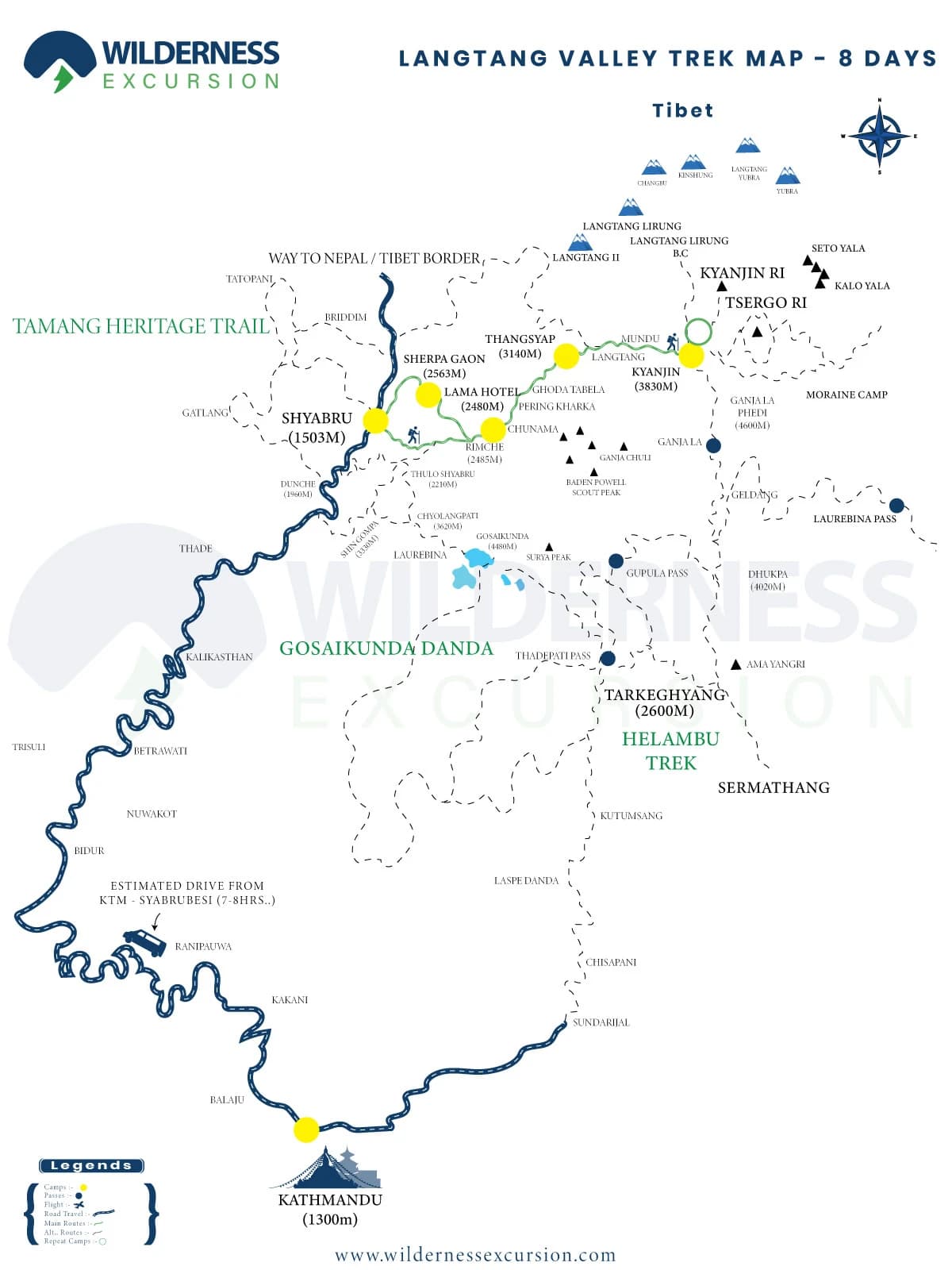
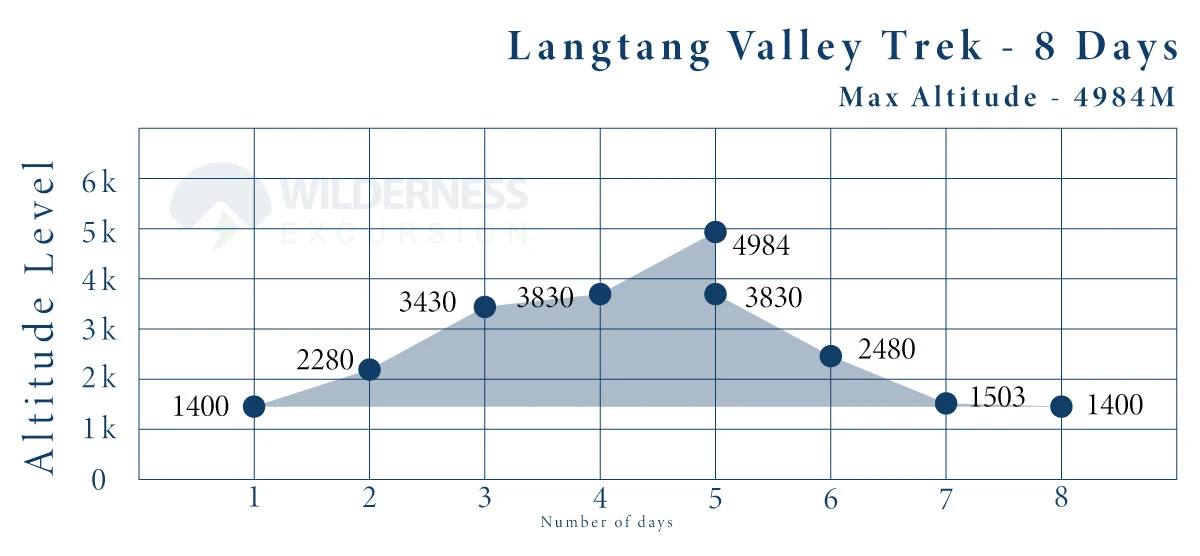
- A licensed Langtang Valley trekking guide.
- Meals: 7 breakfasts, 8 lunches, and 7 dinners during the trek.
- Kathmandu-Syabrubesi - Kathmandu by public bus or local shared Jeep (less leg room)
- Accommodation during the trek is on a double-shared basis.
- Guide fees and all his/her expenses.
- Insurance and trekking gear for your trekking crew.
- Necessary Langtang Valley trekking permits.
- Local taxes.
- Transfers, accommodation, and meals in Kathmandu.
- Guided sightseeing and monument entrance fees in Kathmandu.
- Ant kinds of table drinks.
- Hot shower and hot water, laundry, and toiletries.
- Personal travel insurance, internet, phone calls.
- Porter to carry main pack (US$ 20 per day per porter)
- Rescue operation charge in case of emergency.
- Tipping your guide/driver.
At Wilderness Excursions, we have 13 years of excellent operation and decades of expertise in leading the Langtang Valley Trek in Nepal. To further enhance your trip, we are pleased to introduce exclusive add-on options for even more exceptional choices.
- Porter Service USD 160: Travel lighter, explore further. Let our porter carry your gear (up to 23 kg, shared between two), which helps you easily conquer the Langtang Trek.
- Private Jeep Service USD 165: Upgrade your land transportation to a private Jeep for a more comfortable and personalized travel experience. The cost is shared among participants or adjusted based on group size.
Check our dates published to see if it matches your time. We are happy to customize your tour perfectly to match your interests and needs, creating a unique travel experience just for you
Permits and entry fee for the Langtang Valley.
Langtang Valley is protected under legal laws of Langtang National Park. Being close to Tibetan border, trek to Langtang Valley is extremely strict with multiple checkpoints. Primarily trekkers are required to get a National Park ticket of Nrs3000 for foreigner and Nrs 1500 for SAARC nations from the related department of tourism board.
Preparation and packing tips for Langtang Trek
When trekking in areas like Langtang Valley, which are relatively developed for travelers. There are still some preparation methods to make your journey more comfortable and memorable.
What to pack?
- Needed documents (passports, personal identity cards, and license).
- Personal sanitary items.
- Layers of clothes for day and night.
- Sleeping bags and liners, if needed.
- Foldable hydration water bag or water bottle of 2L.
- Water filter or filter tablets if needed.
- Waterproof essentials like raincoats and rain covers for bags.
- Personal first aid kit with basic medical needs.
- Headlights and hand torches.
- Chocolate bars, energy bars, and light snacks.
- Cash in hand (most hotels may support online transactions, but not always practical).
- Power banks or portable solar backups.
How to pack?
There are always travel DIY tips to pack smartly, so it can be useful later. When packing your essentials and optional items, there is a layering method to make it easier to carry and move things.
When it comes to trekking bags:
- Always keep your documents inside a small bag separately.
- At the top or head part, pack your small essentials like sanitary and toiletry items.
- At the bottom, keep your sleeping bag if you have one.
- Layer the middle part of the bag with clothes
- Keep your snacks, other breakables, or frequently needed items in the side pockets or the top part of the bag's body.
These are just a few things that are worth remembering and a simple method to pack things. You can always come up with your own packing method depending on the items and travel duration.
(P.S. In case you have a porter assigned to you, always have your extra weight and luggage packed separately under the weight limit. If possible, use duffel bags and trekking bags.
Travel safety information
Nepal is usually safe for travelling and adventure activities for both international and domestic trekkers. Due to booming tourism industry, even the remote areas and major population of the country is familiar with the concept of trekking and travelling. Although, having a few precautions can be more helpful for unwanted situations.
- Save emergency contact information from the related embassy.
- Carry small pocketknife for emergencies.
- An optional pepper spray for personal safety.
- Always have travel insurance.
What to do after the trek?
After completing the trek, you can either rest in Kathmandu or continue your adventure elsewhere with us, depending on your travel plans. If you plan on doing a Short Hike Near Kathmandu before departure, please feel free to check our site.
Note: If you are planning a round trip of Langtang Valley with Gosaikunda, then you may contact our customer service to arrange a custom-made itinerary in accordance with your needs. Or you may use this link, Langtanggosaikunda, to inquire about the trek.
The Langtang Valley is located in Nepal's Rasuwa District, part of Bagmati Province. Approximately 80 kilometers north of Kathmandu Valley, it falls within the boundaries of Langtang National Park, which shares a border with China's Tibet Autonomous Region to the southwest.
Langtang Valley Trek is typically regarded as a good introduction to high-altitude trekking in the Himalayas. Even though it is categorized as moderately demanding, it offers a balanced mix of adventure and accessibility, making it suitable for trekkers of different skill levels and experience. Please be informed that all treks in Nepal involve walking up and downhill on the mountain trail.
Langtang Valley trek cost generally varies between US$ 450 to 900, depending on factors such as trek duration, mode of services, and group size. Extended itineraries and more comprehensive packages typically command higher prices
The Langtang Valley Trek goes up to 3,830 meters (12,566 feet) high at Kyanjin Gompa, where you sleep at the highest altitude, and if you take a detour to Tsergo Ri, then it is 4,995 meters (16,352 feet) high. For those who can not hike to Tsergo Ri can hike to Kyanjin Ri its height is 4500 meters above sea level.
While hiring a porter for the Langtang Valley Trek is not legally required, it is strongly advised—particularly for trekkers carrying heavy equipment or those seeking a more comfortable and stress-free journey. Porters can assist with luggage transport and provide valuable support throughout the trek. It will cost USD 20 per porter and can be shared between two trekkers. One porter can carry 25kg maximum.
Yes, it is advisable to bring a warm sleeping bag, as teahouses often lack proper insulation and nighttime temperatures can drop considerably, particularly at elevations above 3,000 meters in old months.
Yes, every teahouse you will spend a night have WiFi service though it is not fast. You can subscribe a 4G data if you buy an NTC SIM card which is much cheaper and faster Internet ptopm.
Nepal has 129 ethnic groups in the country and Tamang is one of the biggest ethnic groups among them. Langtang Valley is home to Tamangs and other Tibetan-like cultured in Langtang they claim themself as Tamang having similar language and tradition to Tibetan in the north.
Yes, one can complete this trek walking via Sherpa Gaun and Khanjim this provides you with a loop /small circuit trekking expereince rather than the same way down to Syabrubesi.
Yes, you can combine this trek with following short treks still within the Langftang region:
1) the Gosaikunda Trek
2) the Tamang Heritage Trek,
3) Tilaman Pass Trek,
4) Ganjala Pass Trek
The Langtang Valley Trek is a safe and rewarding experience for solo female travelers, particularly when undertaken with a guide. Nepal is widely regarded as a secure destination for women traveling alone, and the Langtang region is a well-established and accessible trekking route. Wilderness Excursion also has female guide if solo female trekkers.
We received an official email from TAAN (Trekking Agencies Association of Nepal (TAAN) in February 2025, that an official letter from Langtang National Park was sent to TAAN and other related authorities. The park officials requested that all trekkers, foreign and Nepali, should no longer trek solo and should have a trekking guide for the Langtang trek

To fly a drone in the Langtang Valley trek area, you must first register your drone with the Civil Aviation Authority of Nepal (CAAN), acquire the required permits, and obtain prior authorization from the Department of National Parks and Wildlife Conservation. Compliance with all regulatory procedures is mandatory.
(Note: Regulations may change, so verifying with the relevant authorities before your flight is recommended.)
No, It is not necessary but it is your choice whether to tip or not. Your crew directly involved in your service during the adventure tour expect tips from you at the end of the trek. How much to tip. Here is an article that may help you with tipping your guide and porters in Nepal.
The Langtang Valley Trek is suitable for all age groups and is an excellent choice for beginner trekkers. Known as one of Nepal's easiest and most accessible Himalaya treks, it features a relatively low altitude, making it ideal for those seeking a less strenuous adventure.
During the trek, the highest point reached is 3,830 meters at Kyanjin Gompa, with optional detours to Kyanjin Ri (4,380m) and Tserko Ri (4995m) for those looking for additional challenges. If you prefer a scenic and manageable trek without extreme altitudes, the Langtang Valley Trek is a highly recommended option.
Best Time for the Langtang Valley Trek
The ideal trekking seasons for Langtang Valley are typically March to May (spring) and September to November (autumn), offering stable weather and clear mountain views. However, the trek is feasible year-round, with each season presenting unique advantages.
During the monsoon season (June to August), rainfall may obscure some views, but the lush green landscapes and tranquil trails—free from crowds—create a serene trekking experience.
The primary mode of transportation to access the Langtang region is the public bus, which departs daily from Kathmandu in the morning. For a more comfortable journey, travelers may choose to rent a 4x4 vehicle, particularly suitable for groups of four or more. Wilderness Excursion can facilitate private jeep arrangements upon request.
In the Langtang Valley, both Ncell and Nepal Telecom (NTC) provide mobile coverage, though NTC is often favored for its stronger signal. it can be limited and unreliable on bad weather days, particularly in higher altitude areas above Langtang. NCELL doesn't work in higher places.
I recently returned from an incredible trek to Langtang Valley with Wilderness Excursion, and I cannot recommend them enough for anyone looking to explore Nepal’s breathtaking Himalayan landscapes. From start to finish, the experience was seamless, memorable, and filled with...
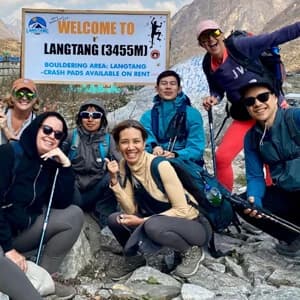
Langtang Valley Trek - an amazing trip!
My partner and I had an amazing first trek in Nepal, creating memories we’ll treasure forever. The Langtang Valley offered some of the most stunning landscapes we’ve ever seen, and the Tsergo Ri...
Langtang Valley Trek – Absolutely amazing hike!
Our first-ever trek in Nepal was Langtang Langtang Valley Trek recently. It was absolutely amazing experience. Once you are above...
